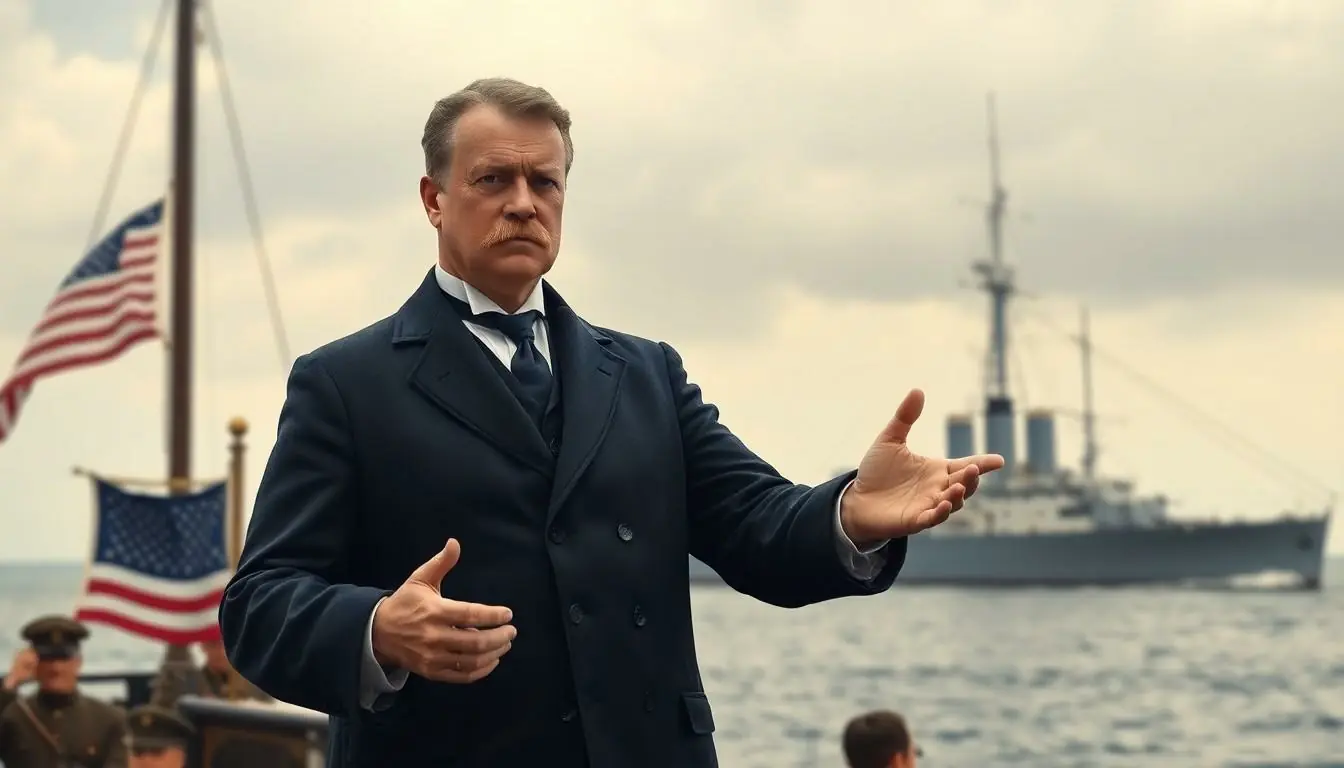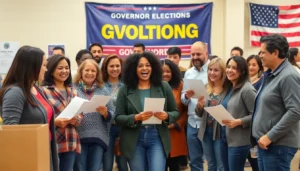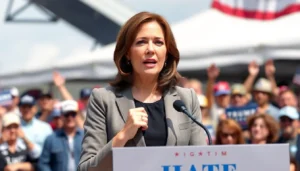In a world where diplomacy often feels like a delicate dance, Theodore Roosevelt introduced a bold twist: big stick diplomacy. Imagine negotiating with a smile while keeping a giant stick behind your back. That’s the essence of this approach—assertive yet strategic. It’s not just about flexing military muscle; it’s about wielding power with finesse.
But what exactly does big stick diplomacy entail? In simplest terms, it’s a policy of negotiating peacefully while being prepared to use force if necessary. This blend of charm and strength has shaped international relations, reminding us that sometimes, a little intimidation can go a long way. Get ready to dive into the world of big stick diplomacy and discover how this age-old strategy remains relevant in today’s global arena.
Table of Contents
ToggleBig Stick Diplomacy Simple Definition
Big stick diplomacy refers to a foreign policy approach characterized by assertive negotiation backed by military readiness. Theodore Roosevelt popularized this strategy during his presidency. Utilizing diplomacy alongside the threat of force creates a balance of power in international relations. Leaders often rely on this method to secure favorable outcomes while maintaining a strong presence.
The phrase “speak softly and carry a big stick” highlights the essence of this approach. Assertiveness becomes crucial in dealing with other nations. Countries adopting this strategy demonstrate a willingness to engage in dialogue, yet they remain prepared to use military power if necessary. This duality fosters respect and encourages compliance from other nations.
Effective big stick diplomacy has historical roots in various global encounters. The United States’ involvement in the Panama Canal exemplifies this tactic. Negotiation with Panama succeeded due to the underlying threat of military action. By showcasing readiness, the U.S. gained control over the canal, achieving significant strategic benefits.
In contemporary matters, world leaders can find relevance in this strategy. Nations that maintain diplomatic relations, while showing military strength, often navigate international challenges more effectively. Displays of power can deter aggressive actions from adversaries. Resulting policies often reflect a blend of diplomacy and readiness to act.
Historical Context

Big stick diplomacy emerged during the early 20th century, significantly shaping U.S. foreign policy. It reflected an era marked by a growing American presence on the global stage.
Origin of the Term
The phrase “speak softly and carry a big stick” originated from Theodore Roosevelt’s belief in a combination of diplomacy and military preparedness. Roosevelt expressed this strategy to convey the importance of negotiating from a position of strength. While engaging in dialogue, maintaining a credible threat of force ensures that adversaries recognize potential repercussions. The term encapsulates a philosophy that balances gentleness with power, enhancing diplomatic efforts.
Key Figures in Big Stick Diplomacy
Key figures influencing big stick diplomacy include Theodore Roosevelt and his advisors. Roosevelt embraced this approach during his presidency from 1901 to 1909, emphasizing military readiness as a tool for diplomacy. Advisors such as William Howard Taft and Henry Stimson further developed these ideas, contributing to interventions in Latin America and the Caribbean. Their collective actions reinforced the practice of using military might to achieve foreign policy objectives, demonstrating the effectiveness of this strategy in real-world scenarios.
Key Principles of Big Stick Diplomacy
Big stick diplomacy hinges on two primary principles: the use of military power and the art of diplomatic negotiations. These elements work in tandem to achieve foreign policy objectives.
Use of Military Power
Military power serves as a crucial component of big stick diplomacy. Leaders leverage a strong military presence to deter adversaries from aggressive actions. This readiness to use force underscores the seriousness of diplomatic efforts. Examples include the U.S. involvement in conflicts where military might influenced outcomes, reinforcing negotiations. By showcasing military strength, nations enhance their bargaining position in international affairs. This approach typically fosters a climate of caution among potential adversaries.
Diplomatic Negotiations
Diplomatic negotiations provide the framework for resolving disputes while minimizing conflict. Leaders emphasize dialogue, aiming to reach agreements beneficial for their nations. Creativity and flexibility in negotiations invite cooperation while maintaining a firm stance. Known historical instances, such as negotiations surrounding the Panama Canal, highlight this balance of firmness and tact. Effective diplomats employ strategies that reflect both persuasion and the potential for military intervention. Strong negotiation skills allow leaders to secure advantageous terms, thus reinforcing the effectiveness of big stick diplomacy.
Impact of Big Stick Diplomacy
Big stick diplomacy has significantly influenced the landscape of American foreign policy, shaping approaches to international relations. The strategy shifted U.S. interactions by integrating military preparedness into diplomatic discussions, creating a framework for assertive engagement.
Influence on American Foreign Policy
Military power reinforces America’s standing in global diplomacy. The approach shifted focus from mere negotiation to a combination that includes credible threats. This change allowed the U.S. to navigate conflicts more effectively, leading to interventions, particularly in Latin America. By combining force and diplomacy, the country strengthened its influence and facilitated the expansion of its interests abroad.
Case Studies
Numerous case studies illustrate the effectiveness of big stick diplomacy. The construction of the Panama Canal exemplifies its impact, where U.S. negotiation succeeded due to the implicit military threat. Another instance includes the Roosevelt Corollary, which justified U.S. intervention in Latin America, showcasing how military readiness can facilitate diplomatic goals. These historical examples demonstrate how having military options available can enhance negotiation outcomes.
Criticism and Controversies
Big stick diplomacy faces several criticisms regarding its moral implications. Critics argue that using military force as a threat undermines the principles of diplomacy. Cases in Latin America highlight instances where such tactics provoked resentment and anti-American sentiment. U.S. actions in Nicaragua serve as an example, illustrating how interventionist policies fostered long-term instability.
Opponents also question the effectiveness of this approach. They assert that relying on threats can lead to damaged international relationships rather than fruitful negotiations. Perceptions of American aggression emerge, causing foreign nations to adopt a more defensive posture.
The approach sometimes clashes with humanitarian ideals. Many see big stick diplomacy as imperialistic, with critics labeling it as an extension of colonialism. Countries resisting such tactics often push back against U.S. influence, deeming it disrespectful to their sovereignty.
Economic consequences arise from prioritizing military readiness over diplomatic engagement. Scholars point to the potential for damaging trade relationships and partnerships when coercive tactics dominate foreign policy. The risk of escalating conflicts increases, placing nations in potential danger.
Historians also note the long-term impacts on global power dynamics. The reliance on military threats can lead to arms races and heightened tensions among nations. In some regions, this strategy has resulted in persistent conflicts rather than peaceful resolutions.
In more recent discussions, the relevance of big stick diplomacy is reassessed in light of contemporary global challenges. Perspectives vary on whether such tactics adhere to modern diplomatic norms or obstruct progress. Instances of diplomacy evolving beyond military threats suggest a need for a more nuanced approach.
Big stick diplomacy remains a significant concept in understanding international relations. Its blend of assertive negotiation and military readiness has shaped U.S. foreign policy for over a century. While it has proven effective in achieving certain objectives, it also invites debate regarding its implications for global diplomacy. The balance between charm and strength continues to resonate in contemporary discussions about how nations engage with one another. As global dynamics evolve, the lessons learned from big stick diplomacy encourage leaders to consider both the power of negotiation and the potential consequences of military threats.





